
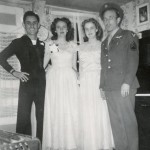 My uncle, George Hushman, became the first in-law in my mom’s family, when he married her sister, Evelyn Byer. He was a novelty, I suppose. I know that is how the younger siblings always feel when it comes to brothers-in-law or sisters-in-law. It all new and fun, and the younger siblings are always made to feel special. Funny thing about little kids, each new family member is as awesome as the last, but somehow that first one always holds a special place in their hearts. It’s like suddenly their horizons are broader. They learn about the fact that there are people outside their little world, who somehow fit into their little world. Then too, as the new children come along and subsequent in-laws are added, the love in the family just seems to grow everyday.
My uncle, George Hushman, became the first in-law in my mom’s family, when he married her sister, Evelyn Byer. He was a novelty, I suppose. I know that is how the younger siblings always feel when it comes to brothers-in-law or sisters-in-law. It all new and fun, and the younger siblings are always made to feel special. Funny thing about little kids, each new family member is as awesome as the last, but somehow that first one always holds a special place in their hearts. It’s like suddenly their horizons are broader. They learn about the fact that there are people outside their little world, who somehow fit into their little world. Then too, as the new children come along and subsequent in-laws are added, the love in the family just seems to grow everyday.
That is how my sisters and I have always felt about Uncle George. I guess it was because we were close in age to their kids, and Mom and Dad were friends with Aunt Evelyn and Uncle George, as well as siblings. Our families did things together, and the two couples did things together, such as bowling. It was their weekly outing, and they always had such a good time. I suppose that is how bowing became a family tradition. It seems that if you enjoy a sport, you pass it down to your kids. Many of both families have bowled at one time or another, and some continue to do so, such as my husband, Bob Schulenberg and me.
Many a New Year’s Eve party included Aunt Evelyn, Uncle George, and their kids, and we always had a great time. My parents liked having a party, because the 1st of January is my mother’s birthday. It seemed a perfect 
 reason to have a big bash. And my sisters and I always felt like it was a better party when the families got together for it…especially if they brought the kids. I’m not sure how some people might have felt about that part, but Mom and Dad always wanted to include the kids, and I think their families appreciated that. I mean, how many New Year’s Eve parties include the kids? Very few. I know that as kids, whenever Aunt Evelyn, Uncle George and their kids were over…it was a good time. Today is Uncle George’s 90th birthday. Happy birthday Uncle George!! Have a great day!! We love you!!
reason to have a big bash. And my sisters and I always felt like it was a better party when the families got together for it…especially if they brought the kids. I’m not sure how some people might have felt about that part, but Mom and Dad always wanted to include the kids, and I think their families appreciated that. I mean, how many New Year’s Eve parties include the kids? Very few. I know that as kids, whenever Aunt Evelyn, Uncle George and their kids were over…it was a good time. Today is Uncle George’s 90th birthday. Happy birthday Uncle George!! Have a great day!! We love you!!
 My niece, Michelle Stevens has been in school for much of her life. Of course, she went through the normal public school, at which time she discovered her amazing talent in the area of art. She also discovered that she was an excellent teacher. Put the two together, and you have a career. With that goal in mind, Michelle set out right after high school to study to become an art teacher. If you think that doctors go to college a long time for their degrees, you will find yourself amazed about the length of time an art teacher has to go. I suppose it is partly the double major, but when you think about the fact that teachers need 4 years, you will begin to understand just how much there is to learn about art. Michelle has been in college for a little over ten years now…but that study time has come to a close. Michelle will wait to march with her class, but with the end of this semester, came the end of her schooling, and her Bachelors Degree. She is done, except for one last day of student teaching today. What a great birthday present that is!!
My niece, Michelle Stevens has been in school for much of her life. Of course, she went through the normal public school, at which time she discovered her amazing talent in the area of art. She also discovered that she was an excellent teacher. Put the two together, and you have a career. With that goal in mind, Michelle set out right after high school to study to become an art teacher. If you think that doctors go to college a long time for their degrees, you will find yourself amazed about the length of time an art teacher has to go. I suppose it is partly the double major, but when you think about the fact that teachers need 4 years, you will begin to understand just how much there is to learn about art. Michelle has been in college for a little over ten years now…but that study time has come to a close. Michelle will wait to march with her class, but with the end of this semester, came the end of her schooling, and her Bachelors Degree. She is done, except for one last day of student teaching today. What a great birthday present that is!!
I’m sure that there must be a feeling of, almost disconnect right now, because Michelle has been in school for  so long. Nevertheless, there also must be feelings of elation and even relief, because the long years of preparation are over, and she can start her career. Michelle is going to make an excellent teacher, and I know that any child she teaches will be very blessed to have her for their art teacher. Her abilities are amazing. I’m not sure what grade Michelle will be teaching, or if she will be teaching multiple grades. She will stay in Spearfish, South Dakota, probably substitute teaching for the rest of this school year, and then I have learned that the plan is possibly to move back to Casper, Wyoming and begin her career here. I know that we would all love that, but I also know that people have to go where the jobs are. I just pray that the jobs will be here for her, because I know that her family would love having her back home so much.
so long. Nevertheless, there also must be feelings of elation and even relief, because the long years of preparation are over, and she can start her career. Michelle is going to make an excellent teacher, and I know that any child she teaches will be very blessed to have her for their art teacher. Her abilities are amazing. I’m not sure what grade Michelle will be teaching, or if she will be teaching multiple grades. She will stay in Spearfish, South Dakota, probably substitute teaching for the rest of this school year, and then I have learned that the plan is possibly to move back to Casper, Wyoming and begin her career here. I know that we would all love that, but I also know that people have to go where the jobs are. I just pray that the jobs will be here for her, because I know that her family would love having her back home so much.
It’s funny that an artist really must get dirty and messy to craft the beautiful pieces of artwork they make. I never really thought of Michelle as being one of those people who would love to get dirty, but I kind of think 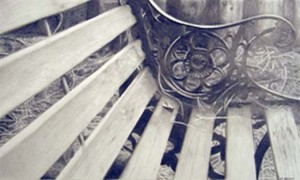 she is. I guess it goes with the career. I haven’t had the opportunity to see all of Michelle’s work, by any stretch of the imagination, but what I have seen is beautiful. I think that every artist has their personal favorite works, and while I’m not sure which one is Michelle’s favorite, I have a favorite of her works. It takes me to a place of peace. A place I love to be…the outdoors. It makes me think of a hike, and coming up of a bench where you can look out over the countryside and drink in all it’s beauty. It might be a simple sketch, and maybe Michelle doesn’t even think it is beautiful, but I do, and they say that beauty is in the eye of the beholder, so there you have it. Today is Michelle’s birthday. Happy birthday Michelle!! Have a great day!! We love you!!
she is. I guess it goes with the career. I haven’t had the opportunity to see all of Michelle’s work, by any stretch of the imagination, but what I have seen is beautiful. I think that every artist has their personal favorite works, and while I’m not sure which one is Michelle’s favorite, I have a favorite of her works. It takes me to a place of peace. A place I love to be…the outdoors. It makes me think of a hike, and coming up of a bench where you can look out over the countryside and drink in all it’s beauty. It might be a simple sketch, and maybe Michelle doesn’t even think it is beautiful, but I do, and they say that beauty is in the eye of the beholder, so there you have it. Today is Michelle’s birthday. Happy birthday Michelle!! Have a great day!! We love you!!
 Last night my sisters and I, along with our families, got together for our 2nd annual Spencer Family Christmas Party. Our family made a commitment long ago, to stay close as a family. Family is so important, and all too often, people lose touch, because they don’t realize the importance of family, or they think there will always be time later. It is never a good idea to put off family until later. I’m thankful that my mom’s parents, George and Hattie Byer asked their kids to stay close, inspiring the annual picnic and Christmas parties to keep us all close, because it was those events, that gave us the inspiration to do the same. Then, our sister, Allyn Hadlock, and her husband Chris decided to host the annual party at their house. What a wonderful blessing that has been for all of us. This year was a smaller crowd, as there were several family members who will be spending Christmas in various locations across the United States, but I know they were there in
Last night my sisters and I, along with our families, got together for our 2nd annual Spencer Family Christmas Party. Our family made a commitment long ago, to stay close as a family. Family is so important, and all too often, people lose touch, because they don’t realize the importance of family, or they think there will always be time later. It is never a good idea to put off family until later. I’m thankful that my mom’s parents, George and Hattie Byer asked their kids to stay close, inspiring the annual picnic and Christmas parties to keep us all close, because it was those events, that gave us the inspiration to do the same. Then, our sister, Allyn Hadlock, and her husband Chris decided to host the annual party at their house. What a wonderful blessing that has been for all of us. This year was a smaller crowd, as there were several family members who will be spending Christmas in various locations across the United States, but I know they were there in  spirit. Of course we missed each one of them, but we understand. I hope that maybe one day, we will be able to have a party with all of us together again.
spirit. Of course we missed each one of them, but we understand. I hope that maybe one day, we will be able to have a party with all of us together again.
The one thing that I have noticed about each of the two parties we have had since our parents left us, is that when we are having the party, it’s like Mom and Dad are there with us. Part of the reason is because of the fact that the conversation always turns to them, and to Christmastimes of the past. The memories of special gifts given and received, moments of surprise, and comical moments too, flood the room…along with the laughter as we reminisce about the Christmases of our lifetimes. Still, it always leaves us with an almost bittersweet feeling. Sweetness, because we have been blessed with such great parents, and that we are making the proud, but bitter, because they aren’t here with us. Nevertheless, we know that we will all be together again.
We really have been blessed with wonderful sisters, and all of the other family members. The family has grown exponentially. Like my mom’s family, we are related to about half of the town. That part in itself is an amazing and wonderful thing. We all feel very blessed by all of the nieces and nephews, grandchildren and great grandchildren, and the wonderful additions that have joined us by marriage. This time of year, we start to think more and more about family, and while I miss my parents more that I could ever say, I am thankful for my sisters, everyday, because sisters really are forever friends.
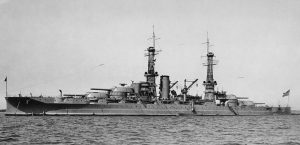 Most people know that the USS Arizona was one of the ships that was bombed when the Japanese attacked Pearl Harbor on December 7, 1941. The USS Arizona’s sinking took with it, 1,177 men…almost half of the total of 2,403 people killed at Pearl Harbor. The Arizona was one of 20 American ships and more than 300 airplanes lost that day. We know that the attack woke the sleeping giant that is the United States, and we joined World War II with the Allies to stop the tyranny that was Japan and later Germany and Italy. Most people know that the Allies were successful in World War II, and after four long years and the loss of over 400,000 lives, the war was over. There are a few facts about the USS Arizona that many people might not know, however.
Most people know that the USS Arizona was one of the ships that was bombed when the Japanese attacked Pearl Harbor on December 7, 1941. The USS Arizona’s sinking took with it, 1,177 men…almost half of the total of 2,403 people killed at Pearl Harbor. The Arizona was one of 20 American ships and more than 300 airplanes lost that day. We know that the attack woke the sleeping giant that is the United States, and we joined World War II with the Allies to stop the tyranny that was Japan and later Germany and Italy. Most people know that the Allies were successful in World War II, and after four long years and the loss of over 400,000 lives, the war was over. There are a few facts about the USS Arizona that many people might not know, however.
Twenty three sets of brothers died aboard USS Arizona. In all there were 37 confirmed pairs or trios of brothers assigned to the ship. Of the 77 men in those sets, 62 were killed. Only one full set of brothers survived. Kenneth and Russell Warriner survived because Kenneth was away at flight school in San Diego, and Russell, while badly wounded, lived. Also on board were father and son, Thomas Free and his son William who served and were killed aboard the Arizona that day. While no regulation exists, US officials discouraged siblings serving on the same ship after the Pearl Harbor attack. In addition to these men who died, the USS Arizona’s entire band, all 21 members, known as US Navy Band Unit (NBU) 22, were lost in the attack. Most of its members were up on deck preparing to play music for the daily flag raising ceremony when the attack began. They instantly moved to man their battle positions beneath the ship’s gun turret. It was the only time in American history that an entire military band died in action. In the years following the attack, and following the decision to leave the dead in the USS Arizona, it was decided that a memorial should be placed there. That is a known fact, but what I didn’t know was that in March 1961, Elvis Presley, who had recently finished a two year stint in the US Army, performed a benefit concert at 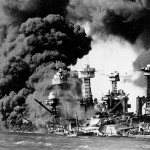
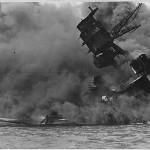 Pearl Harbor’s Block Arena that raised over $50,000. That was more than 10 percent of the USS Arizona Memorial’s final cost. The monument was officially dedicated on May 30, 1962.
Pearl Harbor’s Block Arena that raised over $50,000. That was more than 10 percent of the USS Arizona Memorial’s final cost. The monument was officially dedicated on May 30, 1962.
One of the most surprising facts about the Arizona, however, is related to the fuel. The day before the Pearl Harbor attack, the Arizona had taken on a full load of fuel…nearly 1.5 million gallons, because it was set to make a trip to the mainland later that month. When the Japanese bombers attacked, that fuel played a major part in the explosions and raging fire that followed the bombing. After the fires were put out, there were 500,000 gallons of fuel left in the ship. Now, 75 years later, the Arizona continues to spill up to 9 quarts of oil into the harbor each day. In the mid-1990s, concerns for the environment led the National Park Service to commission a series of site studies to determine the long term effects of the oil leakage. Some scientists have warned of a possible “catastrophic” eruption of oil from the wreckage, which they believe would cause extensive damage to the Hawaiian shoreline and disrupt US naval functions in the area. They continue to monitor the deterioration of the wreck site but are reluctant to perform extensive repairs or modifications due to the Arizona’s role as a “war grave.” In fact, the oil that often coats the surface of the water surrounding the ship has added an emotional gravity for many who visit the memorial and is sometimes referred to as the “tears of the Arizona” or “black tears.”
As surprising as that is, there is still one more fact that many people didn’t know. The bonds between the crewmembers of Arizona have lasted far beyond the loss of the ship on December 7, 1941. Since 1982, the US Navy has allowed survivors of USS Arizona to be interred in the ship’s wreckage upon their deaths. After a full military funeral at the Arizona memorial, the cremated remains are placed in an urn and then deposited by divers beneath one of the Arizona’s gun turrets. More than 30 Arizona crewmen who survived Pearl Harbor  have chosen the ship as their final resting place. Crewmembers who served on the ship prior to the attack may have their ashes scattered above the wreck site, and those who served on other vessels stationed at Pearl Harbor on December 7, 1941, may have their ashes scattered above their former ships. As of November 2011, only 18 of the 355 crewmen who survived the bombing of USS Arizona are known to be alive. I knew that the Pearl Harbor attack had a deep impact on the lives of the survivors, but I guess I didn’t fully understand that it was a life changing event, and it would never really leave them.
have chosen the ship as their final resting place. Crewmembers who served on the ship prior to the attack may have their ashes scattered above the wreck site, and those who served on other vessels stationed at Pearl Harbor on December 7, 1941, may have their ashes scattered above their former ships. As of November 2011, only 18 of the 355 crewmen who survived the bombing of USS Arizona are known to be alive. I knew that the Pearl Harbor attack had a deep impact on the lives of the survivors, but I guess I didn’t fully understand that it was a life changing event, and it would never really leave them.

 With the thousands of airplanes in the air at any moment, one might think that daily accidents would be common place, but in reality, air travel is actually very safe. Nevertheless, it is not without its tragedies. What tends to amaze me, however, is the fact that relatively few ever seem to crash in a city, even though the airports are usually very near cities. Still, there is not a perfect record of missing the cities, when it comes to plane crashes either, and when a plane crashes in a city, you know that the death toll will be higher, and more than likely will include people on the ground, who were just going about their day, completely unaware of the danger they were in.
With the thousands of airplanes in the air at any moment, one might think that daily accidents would be common place, but in reality, air travel is actually very safe. Nevertheless, it is not without its tragedies. What tends to amaze me, however, is the fact that relatively few ever seem to crash in a city, even though the airports are usually very near cities. Still, there is not a perfect record of missing the cities, when it comes to plane crashes either, and when a plane crashes in a city, you know that the death toll will be higher, and more than likely will include people on the ground, who were just going about their day, completely unaware of the danger they were in.
Such was the case on this day, December 16, 1960, in New York City, when two commercial airliners, a United  DC-8 from Chicago, that was heading to Idlewild Airport…now renamed John F Kennedy International Airport, in southern Queens, and a TWA Super Constellation from Dayton, Ohio that was heading to LaGuardia Airport in northern Queens, collided over the city, killing 134 people in the planes and on the ground. This remains the only such accident to occur over a major US city to this day. It was snowing that morning, and the United flight had been put into a holding pattern. Unfortunately, the pilot miscalculated the location of the pattern, the plane came directly into the path of the TWA flight, who was on approach to LaGuardia Airport. There were 128 people onboard the two planes, and all of them, except eleven year old Stephen Baltz were killed on impact. The boy would die from his injuries the next day, but he was lucid enough to give a brief account of the accident, saying that, “It looked like a picture out of a fairy book. Then all of a sudden there was an explosion. The plane started to fall and people started to scream. I held on to my seat and then the plane crashed.”
DC-8 from Chicago, that was heading to Idlewild Airport…now renamed John F Kennedy International Airport, in southern Queens, and a TWA Super Constellation from Dayton, Ohio that was heading to LaGuardia Airport in northern Queens, collided over the city, killing 134 people in the planes and on the ground. This remains the only such accident to occur over a major US city to this day. It was snowing that morning, and the United flight had been put into a holding pattern. Unfortunately, the pilot miscalculated the location of the pattern, the plane came directly into the path of the TWA flight, who was on approach to LaGuardia Airport. There were 128 people onboard the two planes, and all of them, except eleven year old Stephen Baltz were killed on impact. The boy would die from his injuries the next day, but he was lucid enough to give a brief account of the accident, saying that, “It looked like a picture out of a fairy book. Then all of a sudden there was an explosion. The plane started to fall and people started to scream. I held on to my seat and then the plane crashed.”
The TWA plane crashed onto Miller Field, a military airfield on Staten Island. The United flight, which was missing its right engine and part of a wing, came down in the middle of the Park Slope neighborhood of Brooklyn, narrowly missing Saint Augustine’s Academy. It hit an apartment building and the Pillar of Fire Church. Dozens of other buildings caught fire in the resulting explosion. Mrs Robert Nevin, who was sitting in a 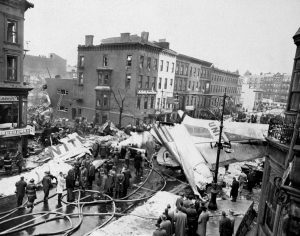
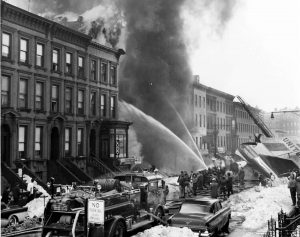 top floor apartment when the place crashed into her building, later said “The roof caved in and I saw the sky.” Six people on the ground died when the plane crashed, including the 90 year old caretaker of the church, Wallace Lewis, and two men who were selling Christmas trees nearby. Christmas presents carried by the plane’s passengers were strewn all over the streets. Firefighting efforts went on for nearly 72 hours because of the multiple fires.
top floor apartment when the place crashed into her building, later said “The roof caved in and I saw the sky.” Six people on the ground died when the plane crashed, including the 90 year old caretaker of the church, Wallace Lewis, and two men who were selling Christmas trees nearby. Christmas presents carried by the plane’s passengers were strewn all over the streets. Firefighting efforts went on for nearly 72 hours because of the multiple fires.

 When we think of dinners with the President of the United States, we think of state dinners with tons of security, and massive pre-planning. Presidential dinners have changed distinctly since Washington’s day. The nation was much smaller for sure, and he could easily get together with all of his advisors and Congress in one place, I’m sure. In fact, George Washington was basically in uncharted waters. So, he decided that on Thursday evenings, he would have the brightest minds in the nation over for a casual dinner. At that time the nation’s capitol was still in New York City, so those casual dinners were never held in the White House. George Washington and his family lived in executive mansions in lower Manhattan, which was close to other governmental buildings in that era. While Washington entertained foreign dignitaries and other heads of state at public receptions on Tuesdays and Martha Washington regularly invited guests to their home on Fridays, Thursday evenings were reserved for formal dinners with congressional leaders, their wives and close personal friends of the Washingtons.
When we think of dinners with the President of the United States, we think of state dinners with tons of security, and massive pre-planning. Presidential dinners have changed distinctly since Washington’s day. The nation was much smaller for sure, and he could easily get together with all of his advisors and Congress in one place, I’m sure. In fact, George Washington was basically in uncharted waters. So, he decided that on Thursday evenings, he would have the brightest minds in the nation over for a casual dinner. At that time the nation’s capitol was still in New York City, so those casual dinners were never held in the White House. George Washington and his family lived in executive mansions in lower Manhattan, which was close to other governmental buildings in that era. While Washington entertained foreign dignitaries and other heads of state at public receptions on Tuesdays and Martha Washington regularly invited guests to their home on Fridays, Thursday evenings were reserved for formal dinners with congressional leaders, their wives and close personal friends of the Washingtons.
In reality, these dinners were elaborate affairs. They started promptly at 4:00pm, because Washington refused to wait for latecomers. I guess every president has his own idiosyncrasies. The parties numbered up to two dozen people, gathered around a table set with the Washington family silver and china. Unlike some state dinners, in which the President and his wife occupy the head of the table, Martha Washington preferred to sit in the middle of one side of the long table and President Washington sat directly across from her. The ends of the table were occupied by a secretary to help with the conversation and roast carving. The roast carving was necessary too, because there were a lot of roasts to be carved. The dinners were comprised of three courses, but that did no limit the selection. There would commonly be upwards of twenty different dishes in each course…all of which were brought to the table at the same time.
The various dishes were the finest that New York had to offer, and the guests were lavished with the exquisite meals. Manhattan was in the middle of New York City, but in 1700, it was still quite wild. The island had an assortment of venison, rabbit, and duck that were hunted for food. Oysters were abundant in the Hudson River. Jellies, dried fruits and nuts were served alongside, although you wouldn’t have seen potato or tomato dishes, because those foods were regarded as unfit for humans to eat in those days. Wine was drunk with dinner, although George Washington was said to prefer a tankard of ale over a glass of claret.
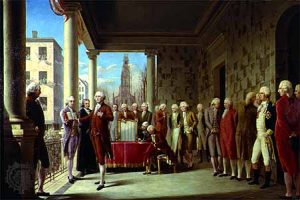
When dinner was over, Washington would raise a toast to the assembly, and then the ladies would retire to Martha’s drawing room for “coffee and civilized conversation.” The gentlemen would remain in the dining room, lingering over cigars and wine, but not for very long. The president only stayed another thirty minutes before joining the women in the drawing room. One of his personal secretaries would stay on in the dining room with the men to preside over political chats for another hour or so, until the company left and the Washingtons’ Thursday dinner was over…until the next week. George Washington passed away on this day, December 14, 1799.
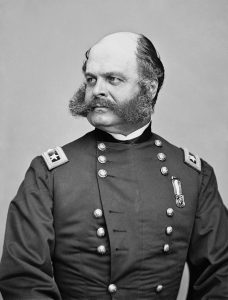 Those who have studied the Civil War, or know much about the United States at all, know that the Civil War was won by the Union, but that does not mean that there weren’t battles that they lost. There are very few wars that are lopsided in their battle field victories. One such battle was the Battle of Fredericksburg. On December 11, 1862, Ambrose Burnside, newly placed in command of the Army of the Potomac, planned to cross the Rappahannock River in Virginia with over 120,000 troops. When he finally crossed it, two days later, on December 13, 1862, he confronted 80,000 troops of Robert E Lee’s Confederate Army at Fredericksburg. With 200,000 combatants, this was the largest concentration of troops of any Civil War Battle. It was also one of the battles the Union Army would lose. In a crushing defeat, the Union Army suffered nearly 13,000 casualties, while the Confederate Army only lost 5,000.
Those who have studied the Civil War, or know much about the United States at all, know that the Civil War was won by the Union, but that does not mean that there weren’t battles that they lost. There are very few wars that are lopsided in their battle field victories. One such battle was the Battle of Fredericksburg. On December 11, 1862, Ambrose Burnside, newly placed in command of the Army of the Potomac, planned to cross the Rappahannock River in Virginia with over 120,000 troops. When he finally crossed it, two days later, on December 13, 1862, he confronted 80,000 troops of Robert E Lee’s Confederate Army at Fredericksburg. With 200,000 combatants, this was the largest concentration of troops of any Civil War Battle. It was also one of the battles the Union Army would lose. In a crushing defeat, the Union Army suffered nearly 13,000 casualties, while the Confederate Army only lost 5,000.
People might think that Burnside was not much of a commander, but it should be mentioned that this was the first time he had commanded an army. He was a graduate of West Point, had risen quickly up the ranks, and had seen action in several battles prior to this fateful day. Abraham Lincoln had approached him about taking control of the Union’s Army. He hesitated, partly out of loyalty to the current commander and former classmate, and partly because he was unsure of his own ability. In the end the prior commander’s failure assured that he was on the way out, and rather than have Major General Joseph Hooker, a fierce rival, pass him up, Burnside accepted the commission on November 7, 1862.
Knowing that he had to have the element of surprise, Burnside came up with a plan to confront Lee’s Army of Northern Virginia at Fredericksburg. He planned to move his forces to the banks of the neighboring Rappahannock River, and then transport his men across by way of hastily assembled pontoon bridges, and surprise the enemy. Lincoln was impressed with the audacity of the plan and approved it, but expressed doubts about its potential for success. Burnside swung into action, reaching the banks of the Rappahannock by November 19, 1862. We will never know if the plan might have succeeded, if some Union generals, including Winfield Scott Hancock, who believed the river could be crossed without the boats, had sent the boats…but instead, they urged Burnside to act without them. Burnside, who believed the river was too swift and deep, refused. They waited a week for the boats…unfortunately, under the watchful eyes of the Confederate scouts.
The element of surprise was gone. When they finally began building the pontoon bridges, the Confederate Army opened fire. Burnside began a massive bombardment of Fredericksburg, in the first shelling of a city in the Civil War. They were able to hold back the Confederate Army long enough to finish the bridges, and then they rushed across the river. Two days later, Burnside ordered his left flank to attack Lee’s right, in the hopes that Lee would have to divert forces to the south of the city, leaving the center and Marye’s Heights vulnerable. For a few hours, it looked like this might actually work. General George Meade broke through “Stonewell” Jackson’s line, but the Union failed to send in enough reinforcements to prevent a successful Confederate counterattack. Lee was able to keep James Longstreet’s men in position at Marye’s Heights, where they decimated Union forces. Burnside lost eight men for every Confederate soldier lost there. Though Burnside briefly considered another assault, the battle was over. The Union had suffered nearly 13,000 casualties while the Confederates lost fewer than 5,000. They needed to regroup before attacking again.
Burnside was an unpopular commander, partly I’m sure, because he felt the need to rush into things without really planning them out. His feelings of inadequacy proved to be his downfall. As he was planning his next attack, some of his leaders went to President Lincoln to voice their concerns. In the end, Lincoln halted the attack. On January 20, 1983, Burnside was ready to go again, but again the pontoon bridges were delayed. The weather didn’t help things either. What had been a dry January turned rainy, and the roads were all but impassible. Troops that had covered 40 miles a day on their way to Fredericksburg now struggled to get further than a mile. For three days, Burnside’s troops continued their disastrous slog on what would become known as the “Mud March,” accompanied most of the way by jeering Confederate forces taunting them from dry land. Five days after his offensive began, it was over…and so was Burnside’s brief, six week stint as commander of the Army of the Potomac. Lincoln immediately removed him from command, replacing him with the very person he feared it would be…Joseph Hooker.
Fredericksburg was the low point in the war for the North, but the South was ecstatic. Burnside probably should have stuck to his side career…weaponry design. And that was what he went back to. He retired in 1853 and in 1856 received his first patent for a .54 caliber breech loading firearm. Impressed with the carbine’s performance, the U.S. Army awarded the Bristol Firearm Company in Rhode Island…where Burnside worked…with a $100,000 contract. The order was soon rescinded, however, under shady circumstances. It’s believed that a rival munitions company bribed the army ordinance department to switch suppliers. Burnside’s bad luck continued the next year when a failed bid for a Congressional seat, followed closely by a fire that destroyed the Bristol factory, forced the financially strapped Burnside to sell his patents. Others would reap the rewards 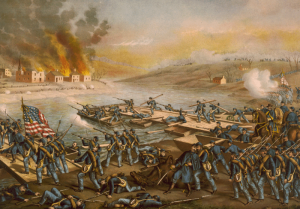 when, at the start of the Civil War, demand for his creation soared. By 1865, more than 55,000 carbines had been ordered, and the Burnside had become one of the most popular Union weapons of the war, second only to the Sharp carbine and my ancestor, Christopher Spencer’s Spencer carbine.
when, at the start of the Civil War, demand for his creation soared. By 1865, more than 55,000 carbines had been ordered, and the Burnside had become one of the most popular Union weapons of the war, second only to the Sharp carbine and my ancestor, Christopher Spencer’s Spencer carbine.
Burnside would eventually have a claim to fame, but it would not be for war or weapons. Burnside liked to wear his facial hair in what was an unusual way for the times. He had a bushy beard and moustache along with a clean-shaven chin. These distinctive whiskers were originally dubbed “burnsides,” but later the term would be altered and would become “sideburns.”

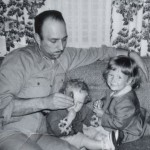 Nine years ago today, my world, and that of my mom and sisters was turned upside down when Dad left us to go to Heaven. I don’t think we will ever feel like things on Earth are normal again, because obviously, normal for us was having him in our lives on a daily basis. It’s hard to pass this day without feeling a sense of loss…no matter how many years have passed, because all that’s left to us are the memories.
Nine years ago today, my world, and that of my mom and sisters was turned upside down when Dad left us to go to Heaven. I don’t think we will ever feel like things on Earth are normal again, because obviously, normal for us was having him in our lives on a daily basis. It’s hard to pass this day without feeling a sense of loss…no matter how many years have passed, because all that’s left to us are the memories.
Memories of childhood days come up in my memory first. The many camping trips our parents took us on, and the things we saw, and learned, and did. It was Dad that taught us how to read a map by taking out the atlas and allowing us to help map out our trips. My friends had no idea how to read a map, and while I use GPS these days, I can read a map without any trouble. It was Dad who taught us to build a campfire, and we who taught him that girls are sure that if Dad puts another log on the fire, the bears will stay away. It was Dad who filled us with the wonders our great nation had to offer by taking his family all over the country, and showing us things like the Statue of Liberty, the Grand Canyon, Washington DC, the Black Hills, Glacier National Park, Yellowstone National Park, the Atlantic and Pacific Oceans, and so much more. Our summer vacations were filled with adventure, and we knew that we were very blessed.
As we grew, our relationship obviously changed, but the values that Dad, and Mom too, taught us remained. Dad was always one to live by the Biblical principle, “Never let the sun go down on your wrath,” and so if we argued with each other, or our parents, Dad would be the one to come to us and tell us that we had to make up before the day ended. We may not have felt like doing so, but we obeyed Dad, because he was our dad. I can’t say that I have ever regretted making up with my family, although I may not have liked it at the time. It was what kept our family close. Dad knew the importance of forgiveness, and instilled that in us too.
As my parents grew older, time was the top priority for them. They wanted their daughters to come over…often, to spend time with them. And they wanted the grandchildren to come too. Their family was the top priority, and they wanted us to know how much we meant to them. Lunches spent at their house, with all the 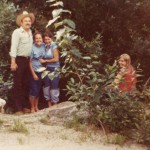
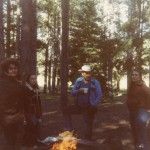 girls talking, and Dad barely getting a word in edgewise, were the normal things in their house. I don’t think Dad really minded that either. He loved hearing the voices and the laughter of his girls, and seeing their smiling faces. Dad was all about family, and I will never regret the lunches and evenings spent there, because that was when blessings took on the feeling of warmth. It saddens me that my dad has been gone for nine years now, and all that’s left are the memories…but I am very thankful for those memories, because they are what keeps him close. We love and miss you so much Dad.
girls talking, and Dad barely getting a word in edgewise, were the normal things in their house. I don’t think Dad really minded that either. He loved hearing the voices and the laughter of his girls, and seeing their smiling faces. Dad was all about family, and I will never regret the lunches and evenings spent there, because that was when blessings took on the feeling of warmth. It saddens me that my dad has been gone for nine years now, and all that’s left are the memories…but I am very thankful for those memories, because they are what keeps him close. We love and miss you so much Dad.

 With each passing year, I find myself looking forward more and more to the Byer Family Christmas Party. Sadly, I think that part of the reason is that as time passes, we seem to lose more and more of my aunts and uncles. This year found us with only four aunts and only one uncle at the party. There are other uncles who are still alive, but that aren’t really able to come out for these events any more. It makes each time we get together that much more precious. I always feel sorry for those who didn’t make it to the party, because we always have such a nice time, and we are a family of excellent cooks, so the food is fabulous. And it is a way to keep those who have gone to Heaven just a little closer to the family. Nevertheless, the sadness over missing those who have left us persists, and grows with each new passing.
With each passing year, I find myself looking forward more and more to the Byer Family Christmas Party. Sadly, I think that part of the reason is that as time passes, we seem to lose more and more of my aunts and uncles. This year found us with only four aunts and only one uncle at the party. There are other uncles who are still alive, but that aren’t really able to come out for these events any more. It makes each time we get together that much more precious. I always feel sorry for those who didn’t make it to the party, because we always have such a nice time, and we are a family of excellent cooks, so the food is fabulous. And it is a way to keep those who have gone to Heaven just a little closer to the family. Nevertheless, the sadness over missing those who have left us persists, and grows with each new passing.
I think one reason that our grandparents wanted their children to continue the annual Christmas party and annual picnic was so that we would all get to know each other better. As the new generations come along. It would be so easy to lose touch with each other. That would be so sad, because little kids are usually instant 

 friends, and that makes it extra special to watch. The kids had a sparkle in their eyes, and smiles on their faces. They were so excited to have new friends to play with and lots of room to run around, with no one to get upset at them. For kids, Christmas is always a special time of year, and it’s really hard to hold back the excitement. I love watching them bounce around the room. I could say that they ran around the room, but that wouldn’t be right exactly, because they really did bounce with excitement, and after all, it’s all about the kids right.
friends, and that makes it extra special to watch. The kids had a sparkle in their eyes, and smiles on their faces. They were so excited to have new friends to play with and lots of room to run around, with no one to get upset at them. For kids, Christmas is always a special time of year, and it’s really hard to hold back the excitement. I love watching them bounce around the room. I could say that they ran around the room, but that wouldn’t be right exactly, because they really did bounce with excitement, and after all, it’s all about the kids right.
My grandparents were wise people. They had a vision for their kids and grandkids…for all of the generations that would follow them. They knew how easy it is to get busy in life, and to lose touch with family. It happens 
 in so many families, and they didn’t want that for their family. Very wise people indeed. They wanted their kids not only to know their nieces and nephews, but also their grand nieces and nephews, and great grand nieces and nephews, for as long as they lived. What a precious gift that request turned out to be. It was not a burden to be carried or work to be done…it was a gift, and one I am thankful for every single year. It’s a time for family and reconnecting. While we miss all those who are gone now, I know that they would be proud of us for continuing this tradition. We love you all.
in so many families, and they didn’t want that for their family. Very wise people indeed. They wanted their kids not only to know their nieces and nephews, but also their grand nieces and nephews, and great grand nieces and nephews, for as long as they lived. What a precious gift that request turned out to be. It was not a burden to be carried or work to be done…it was a gift, and one I am thankful for every single year. It’s a time for family and reconnecting. While we miss all those who are gone now, I know that they would be proud of us for continuing this tradition. We love you all.

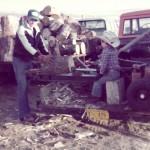 My nephew, Barry Schulenberg, and his wife, Kelli have been doing some remodeling on their bathroom and their home outside of Casper, Wyoming. Barry has a knack for carpentry, and that reminds me of the little boy that was Barry, helping his grandpa, my father-in-law, Walt Schulenberg build the family home north of Casper. It seems like so many years ago, and yet in my memory files, I can see it so clearly. In those days, Barry wanted to do anything his grandpa was doing…so much so, in fact, that Barry had decided that he didn’t need to go to school. He was just going to go to work with his grandpa. I can’t say exactly how much Barry learned about carpentry from his grandpa in those days, but I think he took something away from that experience, even as a little two year old boy. I think he found that he liked to build things, but more than that, it built a bond between grandfather and grandson that would last a lifetime.
My nephew, Barry Schulenberg, and his wife, Kelli have been doing some remodeling on their bathroom and their home outside of Casper, Wyoming. Barry has a knack for carpentry, and that reminds me of the little boy that was Barry, helping his grandpa, my father-in-law, Walt Schulenberg build the family home north of Casper. It seems like so many years ago, and yet in my memory files, I can see it so clearly. In those days, Barry wanted to do anything his grandpa was doing…so much so, in fact, that Barry had decided that he didn’t need to go to school. He was just going to go to work with his grandpa. I can’t say exactly how much Barry learned about carpentry from his grandpa in those days, but I think he took something away from that experience, even as a little two year old boy. I think he found that he liked to build things, but more than that, it built a bond between grandfather and grandson that would last a lifetime.
Over the years, Barry helped his grandfather do anything he was doing. From splitting wood to working on cars, the two of them were almost inseparable, except for the inevitable job/school times that each had to go to. Barry lived for the time when his grandpa would be home from work and they could go work outside. I’m not sure if my father-in-law felt worn out or not, but if he did, he rarely showed it to Barry. They were best buddies and that was all that mattered. The three granddaughters that my father-in-law had then, were his little princesses, and were treated as such, but Barry was his working buddy, and that was just the way it was. I think the girls were ok with that too, because carpentry and cars really weren’t their idea of fun anyway.
I don’t know if Barry realized how special his relationship with his grandpa was, but I really hope he did or does now, because it was special. Not every little boy gets to spend the time with their grandfather that Barry did. That was a blessing beyond blessings for both of them, and it was special to watch too. My father-in-law has 
 been gone now for over three and a half years now. I have to wonder if Barry misses his grandpa as he is working on the current project he has set himself to now. It’s not that Barry can’t do the work himself and with Kelli’s help, but I have to wonder if he doesn’t hear the echo of his grandpa’s voice guiding him through the steps to remodeling the bathroom. His grandpa really knew what he was doing, and to top it off, Barry looks like his grandpa too. No wonder they got along so well. They were two of a kind. Today is Barry’s birthday. Happy birthday Barry!! Have a great day!! We love you!!
been gone now for over three and a half years now. I have to wonder if Barry misses his grandpa as he is working on the current project he has set himself to now. It’s not that Barry can’t do the work himself and with Kelli’s help, but I have to wonder if he doesn’t hear the echo of his grandpa’s voice guiding him through the steps to remodeling the bathroom. His grandpa really knew what he was doing, and to top it off, Barry looks like his grandpa too. No wonder they got along so well. They were two of a kind. Today is Barry’s birthday. Happy birthday Barry!! Have a great day!! We love you!!

